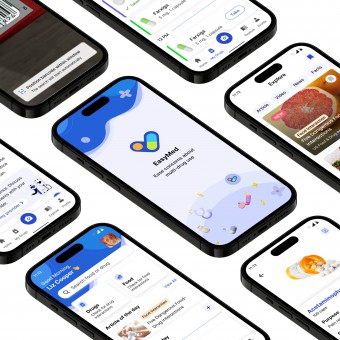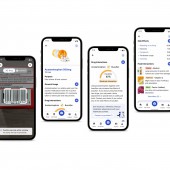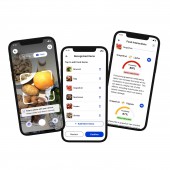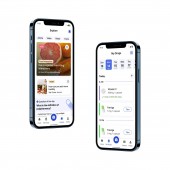
| THE AWARD |
| CATEGORIES |
| REGISTRATION |
| SUBMIT YOUR WORK |
| ENTRY INSTRUCTIONS |
| TERMS & CONDITIONS |
| PUBLICATIONS |
| DATES & FEES |
| METHODOLOGY |
| CONTACT |
| WINNERS |
| PRESS ROOM |
| GET INVOLVED |
| DESIGN PRIZE |
| DESIGN STORE |
| THE AWARD | JURY | CATEGORIES | REGISTRATION | PRESS | WINNERS | PUBLICATIONS | ENTRY INSTRUCTIONS |
Easymed Mobile Application by Lingshuang Kong,Yumei Feng,Shichao Wang |
Home > Winners > Design #157152 >Interview |
 |
|
FS: What is the main principle, idea and inspiration behind your design?
LK: Lingshuang Kong:This insight comes from our visit to the geriatrics department at UCSD Health Medicine, as the physicians told us that many older adults are taking many drugs and they are often concerned about the medical complications and potential interactions. However, the doctor often lacks time to explain every detail to the patients and they also have trouble managing the drugs prescribed by different doctors. To ease the concerns of many older adults or patients who are taking multiple drugs at the same time and reduce the workload for physicians, we decided to design an easily accessible mobile app - EasyMed to help them check any potential drug or food interactions.
FS: What has been your main focus in designing this work? Especially what did you want to achieve?
LK: Yumei Feng: Our primary focus in designing this work is to bridge the gap between medical practitioners and the general population. Our research revealed that doctors often lack the time to provide comprehensive explanations and thoroughly check all medications while understanding patients' medical histories, leading to misunderstandings and adverse drug reactions. We aim to enhance communication and empowerment, particularly for the elderly who are vulnerable to medication errors, by providing an accessible tool for managing medications safely. Additionally, we strive to empower the general public with knowledge, promote medication safety, and improve health literacy. Our goal is to ensure patients understand their medication regimens, make informed healthcare decisions, and experience peace of mind.
FS: What are your future plans for this award winning design?
LK: Lingshuang Kong: There are a couple of things we want to do for EasyMed including further improving the model, iterating on the features, and conducting more user testing. Although the model we used is already close to the highest standard in the industry, we still want to improve the reliability and accuracy of the algorithm through further iteration to ensure we are giving more trustable results to the users. From user research, we also realized that dosage information is important for analyzing drug interactions so we also want to further train our model with this parameter. Through user research, we also learned that doctors and patients use medical record systems like Mychart a lot so we also want to possibly integrate our app with it to improve user experience. In conclusion, the submission of the project doesn’t mark the end of our exploration, we would like to carry this project further and possibly launch it in the Google Store and develop the IOS version in the future so it can benefit more people.
FS: How long did it take you to design this particular concept?
LK: Yumei Feng: Designing this particular concept took two months, given the tight timeline, but it has taken additional months of continuous iteration and improvement since launching the first product. Upon identifying the gap by talking with healthcare professionals during our visit to the geriatrics department at UCSD Health Medicine, we began conducting online research and connecting with patients. The process started with two weeks of extensive research and ideation, including surveys, interviews, and focus groups to understand the needs of medical practitioners and patients, particularly the elderly. This was followed by one week of prototyping and initial design, focusing on usability and accessibility. We then spent a week gathering feedback from our targeted users, integrating their insights while kickstarting the development process. After finalizing our design, we spent two weeks developing the app and simultaneously gathering expert feedback. The final phase was dedicated to validation through additional user testing and expert reviews. We continue to refine the solution, ensuring it effectively bridges the gap between medical practitioners and patients, providing a valuable tool for medication management and health literacy.
FS: Why did you design this particular concept? Was this design commissioned or did you decide to pursuit an inspiration?
LK: Lingshuang Kong: We was inspired to design EasyMed after noticing a significant gap in the healthcare technology market. Astonishingly, no existing competitors specifically address the need for a tailored drug-food interaction checker designed with seniors' accessibility needs in mind. Recognizing this unmet need, we decided to create a mobile app that simplifies the process for seniors, allowing them to easily and effectively check for potential drug and food interactions. This project was not commissioned; it was driven by a genuine desire to enhance patient safety and improve the quality of life for older adults.
FS: Is your design being produced or used by another company, or do you plan to sell or lease the production rights or do you intent to produce your work yourself?
LK: Yumei Feng: Our design is not yet being produced or used by other companies, but we have plans to lease the product and sell it as a service. While similar products exist in the market, none address the needs of the elderly as effectively as ours. We are considering selling it to insurance companies, allowing them to offer it as a benefit to their patients, thereby enhancing patient care and safety. Additionally, we are exploring partnerships with healthcare platforms like MyChart, which would enable seamless integration of our tool into existing systems. This integration would allow doctors to check for potential drug interactions while prescribing medications, further ensuring patient safety and improving healthcare outcomes. Our goal is to make this tool widely accessible to maximize its positive impact on medication management and health literacy, particularly among vulnerable populations.
FS: What made you design this particular type of work?
LK: Lingshuang Kong: Many seniors are navigating the complex maze of multiple prescriptions, which can be overwhelming and dangerous. Clinical examinations for all potential drug interactions are time-consuming and resource-intensive, and overwhelmed medical professionals often can't offer complete guidance to every patient. Globally, approximately 500 million older adults face significant risks associated with polypharmacy. Those using five or more medications have a 50% higher chance of adverse drug interactions. Additionally, they encounter over two potential drug-food interactions monthly, which can sometimes lead to severe health issues or even fatalities.
FS: Where there any other designs and/or designers that helped the influence the design of your work?
LK: Yumei Feng: We definitely take influence from competitors such as WebMD, Drugs.com, and RxList, and actively involve our end users, including the elderly and medical practitioners, as co-designers in the process. We conducted in-depth audits of existing platforms, focusing on their features, UX, and interface design. Our analysis revealed that these platforms are not optimized for the elderly population, who are most susceptible to polypharmacy. We then brainstormed with our users to identify effective solutions to this issue. Their input had a significant influence on our design decisions, allowing us to pivot and create a truly user-centric product.
FS: Who is the target customer for his design?
LK: Lingshuang Kong:EasyMed, our meticulously crafted app, is designed to meet the distinct needs of individuals aged 55 and above, managing 5 or more medications and vulnerable to potential side effects from drug interactions. Concurrently, we aim to alleviate the burden on medical professionals and assist the general public in navigating the complexities of managing multiple medications. - Target User Meet Mary, a 76-year-old we interviewed, managing 5+ medications independently in San Diego. Like many in her demographic, she seeks a comprehensive solution for education and empowerment in navigating drug and food interactions. Alarming statistics highlight that 1 in 25 faces significant drug interactions, 3.2 million Americans misuse drugs, and globally, 500 million elderly may be affected. - Secondary User EasyMed is a valuable tool for healthcare professionals and the general public, streamlining workflows and reinforcing understanding. It reduces the need for exhaustive explanations of every interaction. We aim to support the broader public with a user-friendly platform for discovering potential interactions, extending to supplements, and enhancing overall healthcare literacy. Designed for a global audience, EasyMed is accessible to the global population, minimizing internet bandwidth and optimizing load speed. This commitment to inclusivity ensures accessibility across various socioeconomic statuses.
FS: What sets this design apart from other similar or resembling concepts?
LK: Yumei Feng: In the current landscape, there are indeed competitors in the market. However, our competitive analysis reveals that these alternatives fall short in addressing crucial aspects such as drug-to-food interactions and delivering a satisfactory user experience. Notably, popular apps like RxList, WebMD, and Drugs.com primarily focus on detecting drug-to-drug interactions, lacking the specificity needed for addressing drug to food interactions. Moreover, these existing options are not tailored to the unique needs of the elderly, exhibiting issues such as information overload, poor UI design, and limited functionality. What sets our design apart is its commitment to providing a comprehensive solution that bridges the gap between medical practitioners and patients and empower them with a peace of mind. Our app exhibits a competitive advantage by emphasizing accessible and personalized features, and seamless medical system integration.
FS: How did you come up with the name for this design? What does it mean?
LK: Lingshuang Kong:The name "EasyMed" was chosen to reflect the core mission and functionality of the app. The term "Easy" signifies the app’s user-friendly interface and its goal to simplify the complex task of managing multiple medications and understanding drug-food interactions. "Med" is short for medication, highlighting the app’s primary focus on assisting users with their prescription management. The name "EasyMed" encapsulates the app’s purpose: to make medication management straightforward and accessible, particularly for seniors. By emphasizing ease of use and focusing on essential medication information, EasyMed aims to enhance patient safety and improve the quality of life for its users.
FS: Which design tools did you use when you were working on this project?
LK: Yumei Feng: For this project, we used a mix of design tools at different stages. Initially, we relied heavily on pen and paper for documentation and sketching. During the ideation phase, we used pen and pencil to document findings, take pictures, and jot down notes from interviews. To visualize user journeys and personas, we used Miro, which facilitated collaborative brainstorming and mapping out user flows. Once we had initial flows sketched out, we transitioned to Figma for creating mid-fidelity wireframes, which we iterated into high-fidelity prototypes. These prototypes were then used for user testing, enabling real-time feedback and adjustments. These tools collectively allowed us to iterate quickly, maintain high design standards, and ensure our solution was effectively meeting user needs.
FS: What is the most unique aspect of your design?
LK: Lingshuang Kong: The most unique aspects of EasyMed are its AI-powered features, senior-centered design, and exceptional accessibility: AI-Powered Insights: EasyMed employs cutting-edge machine learning technologies to predict drug-to-drug and drug-to-food interactions based on compounds. This advanced capability provides users with comprehensive and accurate interaction reports, enhancing safety and reliability. Age-friendly Design: Keep the major audience user group - elderly in mind. By choosing an age-friendly design approach, EasyMed ensures widespread accessibility, especially among seniors who often possess smart devices. The user interface features legible fonts, clear instructions, and easy navigation to cater to the unique needs of older adults.
FS: Who did you collaborate with for this design? Did you work with people with technical / specialized skills?
LK: Yumei Feng: We collaborated with a variety of stakeholders for this design: - Medical Practitioners: We examined how they handle polypharmacy concerns and communicate with their patients, ensuring our solution addressed real-world challenges. - Technical Team: Our engineering team included a front-end developer, a back-end developer, and two machine learning engineers. Their expertise was crucial in developing and refining the product. - End Users: Our primary focus was the elderly population, but we also included the general public in our user testing to ensure broader applicability. - Instructors and Advisors: Professor Weibel, our academic instructor with a deep background in medical technologies, and advisors from the UCSD geriatrics department provided valuable insights and guidance. This collaboration ensured that our design was both technically sound and user-centered, addressing the needs and concerns of all relevant stakeholders.
FS: What is the role of technology in this particular design?
LK: Lingshuang Kong: The role of technology in this design is paramount. At the core of EasyMed lies a sophisticated machine learning algorithm. This algorithm is engineered to predict adverse reactions by analyzing compounds present in both food and medications. This technology enables users to accurately assess potential interactions between their prescribed drugs and food items. Additionally, EasyMed incorporates various AI-driven features, such as text-to-speech functionality, drug barcode scans, and food recognition, all aimed at simplifying user experience and enhancing accessibility. Overall, technology is the driving force behind EasyMed's functionality, empowering users to proactively manage their medication interactions and improve their overall healthcare outcomes.
FS: Is your design influenced by data or analytical research in any way? What kind of research did you conduct for making this design?
LK: Yumei Feng: Our design approach is heavily influenced by a combination of analytical research and real-world data, ensuring that our solutions are both effective and empathetic towards the needs of elderly users. Initially, we conducted a field study at a geriatric facility as part of the Human-Centered Computing for Health class at UCSD. This firsthand exposure highlighted the critical issue of polypharmacy among senior adults, where many were found to be taking multiple medications without adequate consideration of potential adverse interactions with other drugs and their diet. To quantify the scope of this issue, we considered alarming statistics such as: 2.2 million older adults in the US are at significant risk due to polypharmacy. There is a 50% increase in the risk of adverse drug interactions with the concurrent use of five drugs. Patients face over two potential drug-food interactions per month when regularly using five drugs. Our research didn’t stop at observational studies. We extended our investigation through user interviews with elderly adults, general users, and medical professionals. These interviews shed light on prevalent challenges like tracking medical records and existing knowledge gaps regarding medication management. Additionally, our online research revealed that none of our competitors offer a drug-food interaction checker tailored to the needs of the elderly, signifying a clear opportunity for innovation. Leveraging these insights, we crafted potential solutions that integrate responsible AI and age-friendly design principles. We further refined our focus by employing an impact versus effort matrix to prioritize the essential features for our Minimum Viable Product (MVP). This strategic blend of quantitative data, qualitative insights, and user-centered design principles forms the backbone of our approach, ensuring that our designs are not only innovative but also deeply rooted in real user needs and challenges.
FS: What are some of the challenges you faced during the design/realization of your concept?
LK: Lingshuang Kong: The first challenge we met was to research and study drug-to-drug/food interaction literature from prior arts. We need to read a lot of literature about DDI/DFI and compare their implementation method and accuracy to find the best one as our ML model algorithm. The second challenge is we can’t directly use the ML model from literature, we need to optimize its efficiency and organize the output which can be understood easily by normal users. Also, since many of our users are older adults, another challenge is how to build a friendly AI product for them. We interviewed older adults to learn their needs and pain points, and found it’s difficult for them to read a heavy text and understand medical terms, so we utilize the Azure text-to-speech service and medical dictionary API to help them use our application. We also made sure the text and font sizes are legible for elder adults and color contrasts are friendly to people with visual impairments.
FS: How did you decide to submit your design to an international design competition?
LK: Yumei Feng: We decided to submit our design to an international design competition because we believe it is crucial for our design to gain visibility and for the pertinent issue it addresses to be acknowledged on a global platform. This recognition not only validates our purpose and mission, affirming that our efforts are meaningful and impactful, but it also provides us with an opportunity to share our mission with a wider audience, thereby amplifying our impact. Personally, my participation in this competition reflects my broader commitment to societal contribution. Professionally, while I am dedicated to driving client success, I am equally committed to making a positive difference in underserved communities. The development of a product like EasyMed exemplifies this commitment, allowing me to contribute significantly to the well-being of minority groups. By showcasing our work in an international arena, we not only highlight our innovative solutions but also inspire collective action towards improved healthcare solutions, making this a deeply fulfilling endeavor that encourages continuous innovation for the greater good.
FS: What did you learn or how did you improve yourself during the designing of this work?
LK: Lingshuang Kong: This competition gives us a great insight into the difficult yet interesting nature of incorporating AI into products. We see how powerful and useful AI systems can be which allows us to develop great products in a short time span but incorporating all different services together was difficult for us. We also realized that there are many limitations and complications with AI systems since there are many ethical considerations to take into account. We kept responsible AI principles and age-friendly design principles in mind when crafting our solutions to ensure that our product is fair and understandable to all. Thinking about the practicability and ethical considerations of using AI was a great learning experience for us. Although all of us had prior experience with product development to some extent, it was still extremely difficult for us to come up with a good idea and implement it in less than a month. We came up with many solutions related to AI initially but decided to settle on this one after interviewing several older adults. We learned that team collaboration, a clear roadmap, and pre-defined goals are extremely important. Although we have set project goals with milestones listed for each timestamp, we are still struggling with unforeseen risks that might hinder us from submitting on time. In conclusion, the project was a great learning experience for all of us and we really enjoyed the process of tackling each challenge.
FS: Any other things you would like to cover that have not been covered in these questions?
LK: Yumei Feng: While we've covered significant ground in this discussion, I would like to highlight our ongoing efforts to ensure that our product, EasyMed, remains accessible and user-friendly for all, particularly for those with limited tech-savviness. We are currently exploring partnerships with community organizations to facilitate workshops that educate seniors on how to effectively use our product. Additionally, I think it’s important to discuss potential scalability plans for EasyMed, considering the aging population globally. Exploring international markets could be a pivotal step for us, and I am keen to delve into strategies for adapting our solution to meet diverse regulatory and cultural landscapes across different regions. This expansion aligns with our mission to make a widespread impact on healthcare accessibility and effectiveness.
FS: Thank you for providing us with this opportunity to interview you.
A' Design Award and Competitions grants rights to press members and bloggers to use parts of this interview. This interview is provided as it is; DesignPRWire and A' Design Award and Competitions cannot be held responsible for the answers given by participating designers.
| SOCIAL |
| + Add to Likes / Favorites | Send to My Email | Comment | View Press-Release |




